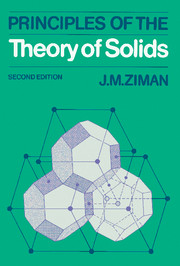Book contents
- Frontmatter
- PREFACE
- PREFACE TO THE SECOND EDITION
- Contents
- Chapter 1 Periodic Structures
- Chapter 2 Lattice Waves
- Chapter 3 Electron States
- Chapter 4 Static Properties of Solids
- Chapter 5 Electron-Electron Interaction
- Chapter 6 Dynamics of Electrons
- Chapter 7 Transport Properties
- Chapter 8 Optical Properties
- Chapter 9 The Fermi Surface
- Chapter 10 Magnetism
- Chapter 11 Superconductivity
- Bibliography
- Index
Chapter 11 - Superconductivity
Published online by Cambridge University Press: 05 June 2013
- Frontmatter
- PREFACE
- PREFACE TO THE SECOND EDITION
- Contents
- Chapter 1 Periodic Structures
- Chapter 2 Lattice Waves
- Chapter 3 Electron States
- Chapter 4 Static Properties of Solids
- Chapter 5 Electron-Electron Interaction
- Chapter 6 Dynamics of Electrons
- Chapter 7 Transport Properties
- Chapter 8 Optical Properties
- Chapter 9 The Fermi Surface
- Chapter 10 Magnetism
- Chapter 11 Superconductivity
- Bibliography
- Index
Summary
Since 'tis Nature's law to change
Constancy ahne is strange.
EAEL OF ROCHESTERThe attraction between electrons
Superconductivity was long considered the most extraordinary and mysterious of the properties of metals; but the theory of Bardeen, Cooper and Schrieffer—the BCS theory—has explained so much that we can say that we now understand the superconducting state almost as well as we do the ‘normal’ state. We shall not attempt here
to cover the whole of a large and rapidly advancing subject; the emphasis will be on the atomic processes from which so many unusual macroscopic phenomena arise.
The whole effect springs from a small force of attraction between any two electrons which have nearly the same energy. We usually assume that free electrons repel one another, through their Coulomb interaction, although, as shown in §5.8, this field is considerably reduced at long distances by the screening effect of the ‘Other’ electrons. But in a lattice an electron tends to pull towards itself the positive ions, so that it is surrounded by a region where the lattice is slightly denser than usual. Another electron coming into the vicinity will be drawn towards this region; it will look as if it were attracted towards the first electron. The two particles can, so to speak, gain by sitting close together in the same depression of the mattress.
- Type
- Chapter
- Information
- Principles of the Theory of Solids , pp. 379 - 414Publisher: Cambridge University PressPrint publication year: 1972



